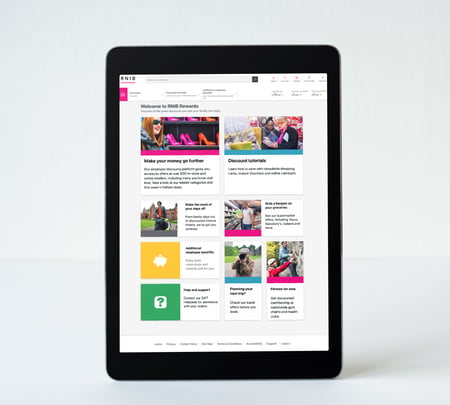3 min read
Accessibility affects many people, and in ways that aren’t always obvious. In practice, accessibility is about designing for users with disabilities. Philosophically, it isn’t so much about designing for disability as it is about designing for everyone.
At Reward Gateway, this is what we’ve set out to do. And not today, which happens to be Global Accessibility Awareness Day, but every day.
Consider these accessibility issues you may not have thought of before - over 60% of the world’s population wears glasses – that’s an accessibility issue. Plus, roughly 50% of people break a bone before the age of 65 - that’s an accessibility issue too.
So how does this translate over to our digital products? Well, we do things on the web more than ever before. Our services have to be accessible to all those who use them, and I believe that designing for people with different needs will result in designs that benefit us all. As a Senior Product Designer with my focus in Usability, you can see how I’ve become incredibly passionate about this topic.
Here’s a little more on our view about accessibility:

But we had to put our words into action. And where better to start than with an organisation that champions accessibility for the visually impaired?
Client Spotlight: Designing a fully-accessible platform for the Royal National Institute for the Blind
RNIB employs a significant percentage of employees with visual impairments and as such, accessibility is important to them, so that all of their employees can access their content and benefits, despite any disabilities they may have to overcome. These visual disabilities could include:
| 1. Photo or light sensitivity |
| 2. Colour blindness |
| 3. The inability to read certain colours of text against screen backgrounds |
The team at Reward Gateway took this challenge to heart, making sure that their employee benefits platform could achieve full accessibility to let users search for content relevant to their needs, accessing benefits and discounts as needed, regardless of their visual acuity.
This kicked off with accessibility testing among Reward Gateway focus groups to determine the best fit solutions that worked with the employee discounts solution the team was launching for RNIB.
Throughout this process, Reward Gateway and RNIB ensured that:
-
Assistive technologies such as screen readers could be used
-
The website could be accessed easily by keyboard-only users
-
Font size and line-height was big enough
-
The contrast ratio between text and background was high enough
-
Products comply with Web Content Accessibility Guidelines.

These accessibility statements were integral to RNIB’s mission, making disabled visitors feel welcomed online, underlying RNIB’s commitment to making resources available to everyone.
How a visually impaired person accesses the RNIB platform
“We are beyond grateful to have access to a discount portal that everyone can enjoy,” said Matthew Niyazi, Reward Officer, RNIB. "With 12 million disabled people living in the UK, it’s just not good enough that over 70% of UK websites do not meet accessibility standards. This is another step towards web inclusivity.”

Since launching with RNIB, we’ve been excited to continue pushing the boundaries when it comes to our responsibility and commitment to accessibility. In addition to the [obligated] Accessibility Statement on our technology, we’ve also introduced a new Accessibility Statement that brings awareness to the importance of making technology accessible to everyone, and truly making the world better, whether you’re at work or not.
 Laz Bosakov
Laz Bosakov



